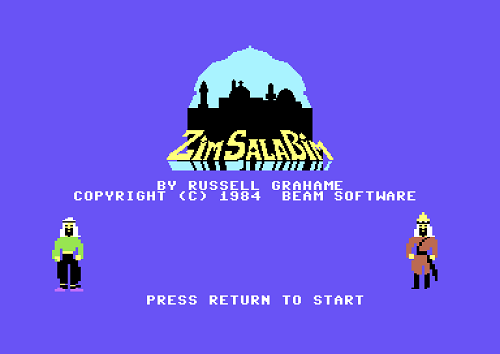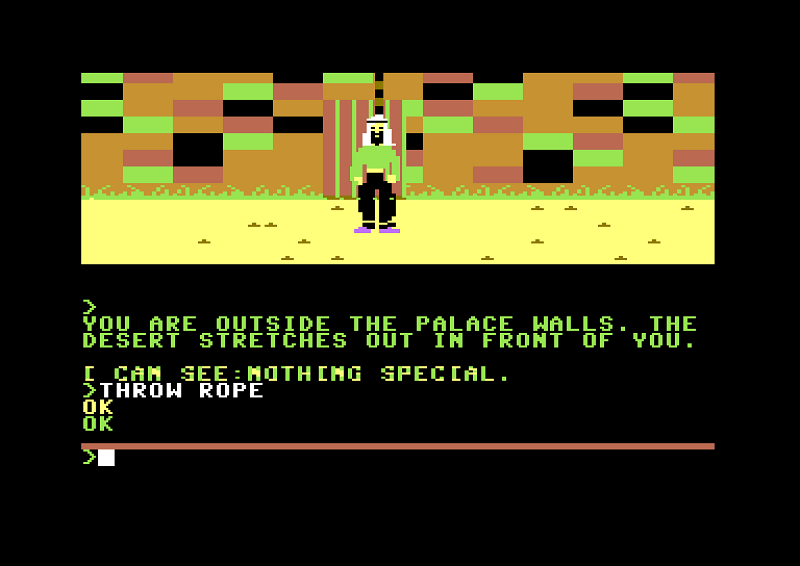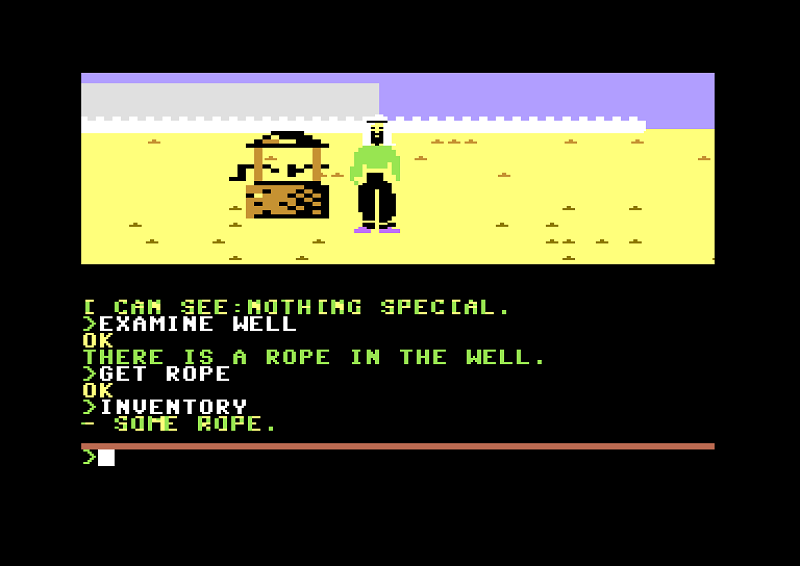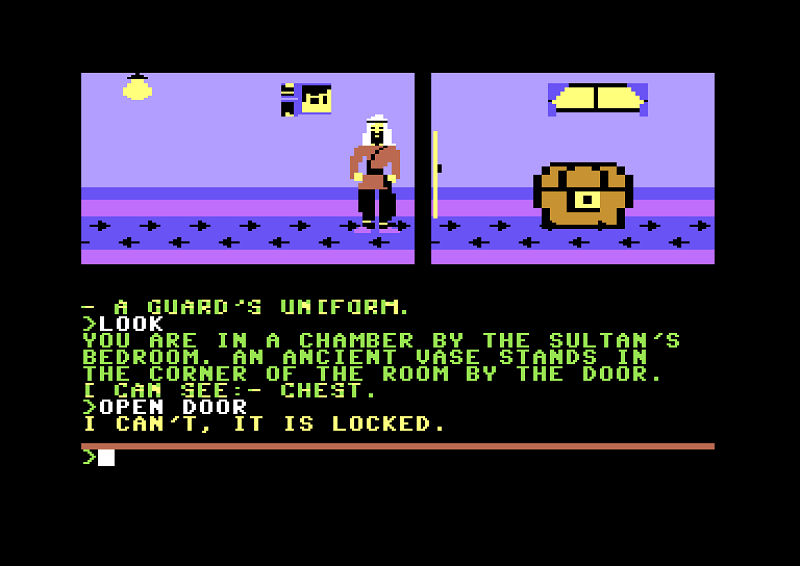Zim Sala Bim
| Developer: | Beam Software |  The title screen. The title screen. |
| Released: | 1984 | |
| Genre: | Fantasy | |
| Graphics: | Pixel art / 2D | |
| Perspective: | Third person | |
| Gameplay: | Parser |
| Note: this is a Commodore 64 game. |
In the Arabian village called Zim Sala Bim things aren't going too well. The greedy Sultan has taken all valuable assets, and people have no money and no food. The only way to get some remedy in the situation is for the protagonist to break into the Sultan's castle and steal his treasures. It sounds like a simple task, but breaking and entering a rich man's castle never is.
Thematically what the game is all about is the Robin Hood theme transferred into historic Middle East in the spirit of One Thousand and One Nights. Why not? It sounds like a great starting point for an engaging adventure. What has been the motivation for the theme can only be guessed, as the Middle Eastern aspect of it is heavily underused. Strictly speaking the magic word Sim Sala Bim, which has been twisted into the name Zim Sala Bim, doesn't even originate from that area. If it weren't for the desert and the protagonist clothing, the game could just as well be a Robin Hood adventure, or any other steal from the bad rich dude story. At least the exotic theme makes it a bit more unique, although the game itself doesn't offer as much excitement as the box front cover of the game does.
 The protagonist in front of Sultan's palace.
The protagonist in front of Sultan's palace.
It's good to be proud of what you have achieved. And apparently the creators of this game are, or at least the publisher is. On the said game box cover it is stated that the game loading time is "less than 3 minutes" (on a cassette media), and that the completion time for the game is "several days". Out of these two estimates of time, the loading time may be correct, but the completion time really isn't. There's very little actual gameplay content in the game, and that should also count for the relatively fast loading times. If there weren't graphical elements in the game, it probably could be loaded much faster, as the actual game probably doesn't take much space.
So how is the game technically like then? Well, there are some interesting design choices. First of all, it is a graphical game, with all locations being visually shown. But the actual gameplay is mostly parser-based. The keyword here being mostly. In a rather unusual fashion, the player gets to directly move the protagonist either by using joystick or keyboard keys, but only sideways. Moving forward and backward is actually command-based. This makes it all seem very strange, as the protagonist doesn't move similarly in all directions. As some kind of explanation, moving forward and backward loads another background, but why this wasn't programmed into joystick or keyboard key inputs is something that the world will most likely never find out.
The parser itself is very simple. It has some interesting innovations in it though. It recognises only the first two characters of each command word. So for example, the commands that were referenced earlier, GO FORWARD and GO BACK, can be conveniently typed as GO FO and GO BA, respectively. While this is very user-friendly, it also means that the parser understands no synonyms at all, the understood commands are listed in the manual. This also means that if using abbreviated commands, some commands get to be confusingly similar. GO FO meaning GO FORWARD might look very similar to GI FO which actually would mean GIVE FOOD. Of course the player should know which commands he is typing in, but the possible wrong keys and typos are harder to spot, as both GO FO and GI FO would be understood by the parser, but given in a wrong context not be executed, or resulting in an undesired action. Nonetheless, the idea behind it is interesting for sure.
 Parser commands.
Parser commands.
There are some interesting graphical details too. The command LOOK actually makes the protagonist turn his head from side to side, and then report what is visible. Also as an idle animation the protagonist is blinking his eyes. These are very good, small things that immediately add some charm to the game. Sadly that is almost the entire list of graphically impressive elements in the game. Otherwise the backgrounds are simple and sparse, and all other human characters are just pixel formations in the background image, some of which really don't even look like humans. There are also some clear glitches, like some background borders being drawn on top of the protagonist when he is moving.
Sadly the game feels unfinished. There are minor, although not game-breaking, glitches here and there. And as already mentioned the game is very short, the only thing that actually can significantly increase playthrough time is one particular puzzle, where the solution is very illogical and requires positioning the protagonist pixel-perfectly. Half of the parser input commands are never needed, and most items in the game world are not needed for anything. There is no reward or ending sequence when completing the game, the game just kind of ends, without even going to the menu image or something like that.
There are some unwinnable states and at least one way to die (without any animation) in the game, but the kind of challenges that the game box graphics and texts might indicate, are nowhere to be found. And the game name itself is somewhat misleading too, as Zim Sala Bim might indicate emphasis on magic, but there is none of that either.
Zim Sala Bim feels like a lost opportunity mostly. What the basic premise is sounds very thrilling and engaging, but the delivery is just not there. The technical execution has its pros and cons, but just ends up feeling unfinished. Compared with other titles of its kind it's not even particularly bad, just one more parser-based adventure game with graphical elements. With a little more content it could have been very good. On the other hand, because the game length is short, there's really nothing to annoy and the gameplay doesn't even get too repetetive. The game could benefit from some magic touch, but repeating either Sim Sala Bim or Zim Sala Bim out loud is probably not going to change much of the game aspects...
 The door is locked.
The door is locked.
